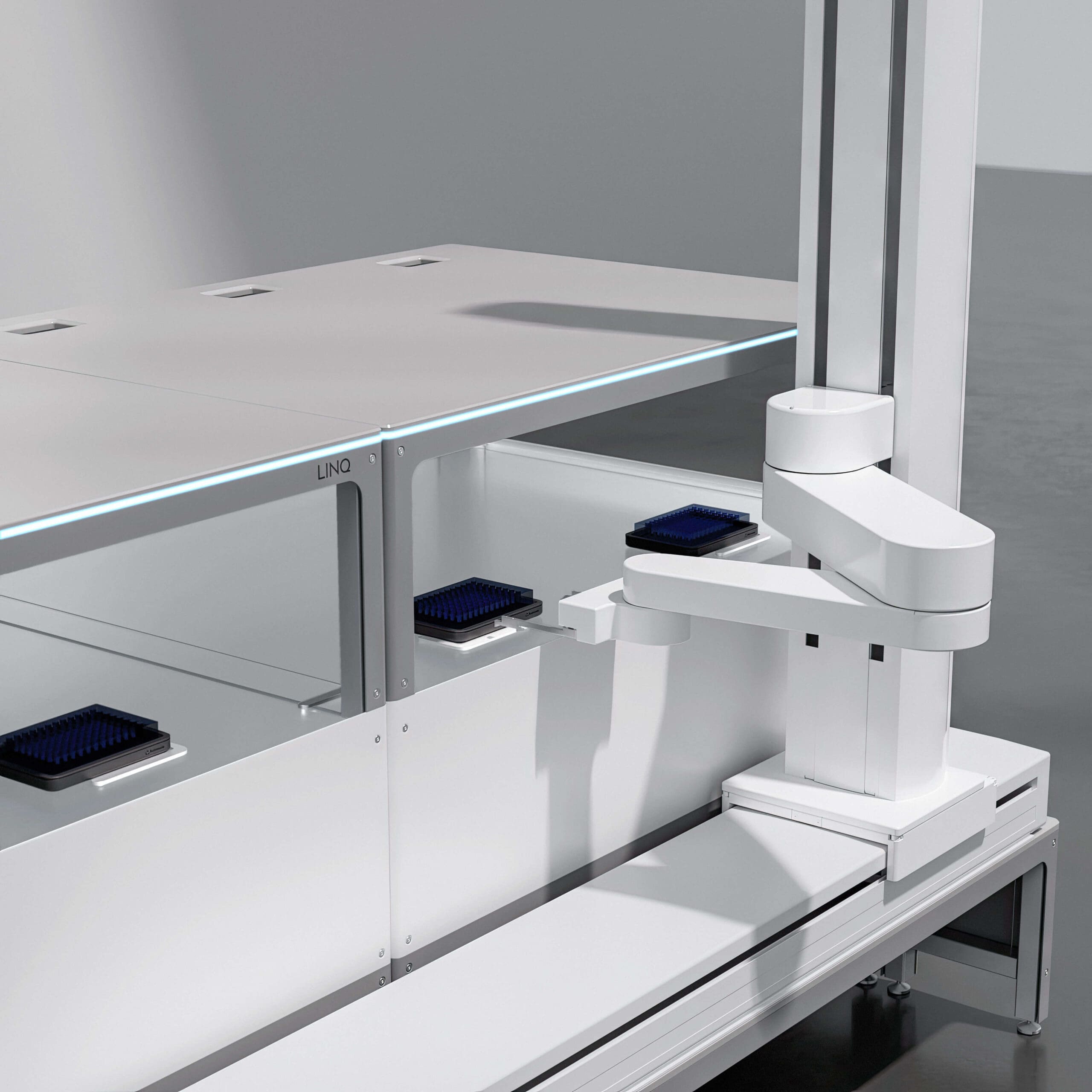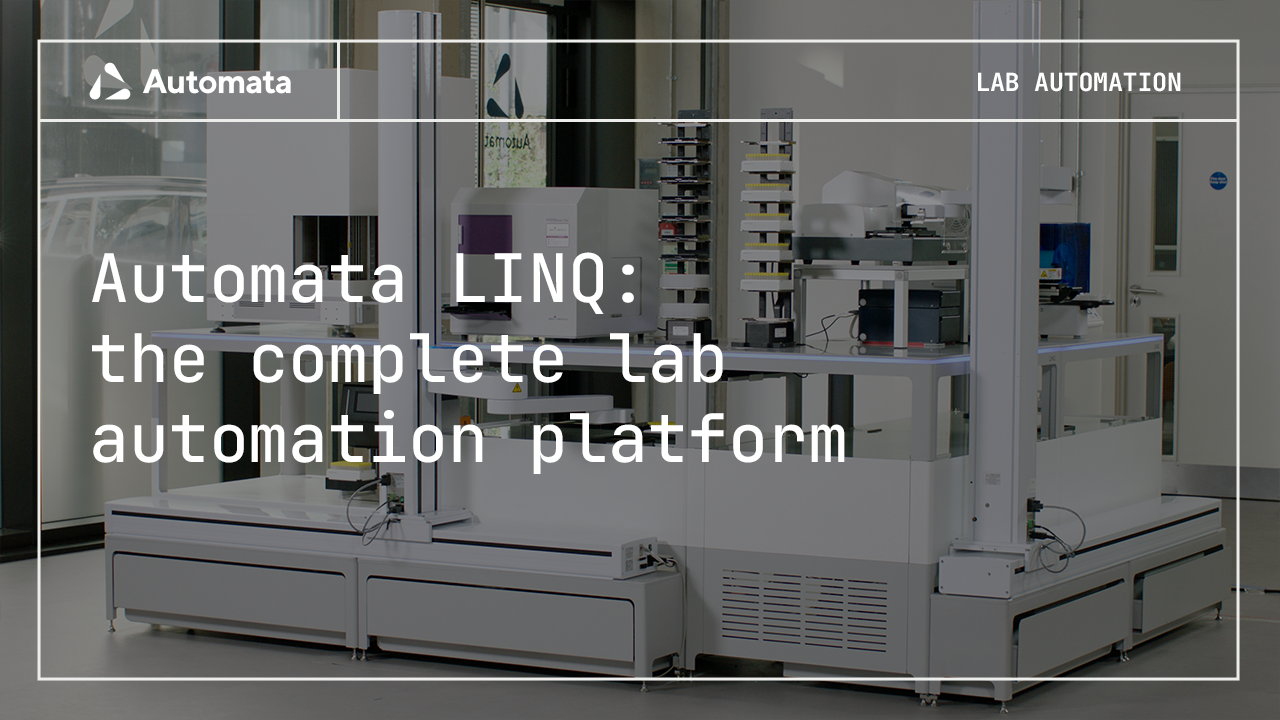Automation has rapidly established itself as a valuable asset within the life sciences industry, pushing throughput, accuracy, and efficiency to greater heights.
This article will explore how automation in life sciences is commonly utilised and the many advantages that it provides before discussing some of the challenges that still exist regarding its implementation.
Applications of automation in the life sciences industry
A diverse array of tasks in life sciences are being augmented or even executed entirely with automated technology, from experiment delivery through to analysis. It would take too long to list them all, but some of the most common uses of automation occur in the following areas:
- Guiding research: the ability to conduct large-scale studies using automated systems for processes like high-throughput screening and sequencing allows researchers to quickly identify targets and leads in drug discovery, for example, while high-quality data sets generated with automation is underpinning a new wave of predictive modelling using AI 2,3
- Conducting laboratory processes: automation is commonplace in certain parts of the laboratory, with actions like liquid handling being ripe for automating. Small-scale or single workcell automation is supporting faster, more accurate ELISA across thousands of labs, while the more advanced facilities are benefiting from automation platforms like LINQ that can execute entire workflows end-to-end without intervention
- Handling data: as data availability and generation continue to increase, the need for automation has become increasingly evident and the technology more widely adopted. Automation can support the standardisation and contextualisation of large data sets 7,8, real-time transfer of highly reliable data from across the lab and even third parties, analysis, collaboration, and even speed of discovery. Advanced automation software like LINQ Cloud supports automated data handling processes 5,6, removing manual interactions to make it more reliable, transferring data automatically, and ensuring results are fully contextualised
How can automation impact life science labs?
Automation in the life science research laboratory can provide a range of benefits, for people and productivity. Some of these benefits include:
- Increased efficiency and productivity. Automation streamlines workflows, reducing manual tasks and increasing the speed of processes. High-throughput solutions allow for the processing of large volumes of samples and data quickly beyond human capabilities
- Enhanced accuracy and precision. Automated systems minimize human error and improve control over conditionals, leading to more reliable and reproducible results
- Cost reduction and sustainability. It reduces labor costs by minimizing the need for manual intervention while decreasing reagent and consumable waste through precise measurement and dispensing
- Improved data management. Automated data collection and analysis ensure consistent and organised data storage, facilitating easier data sharing and collaboration
- Scalability. Automation enables the scaling up of experiments and production processes without a proportional increase in labour or space
- Enhanced safety. By reducing manual interventions, human exposure to hazardous materials and conditions, as well as risks like repetitive strain injuries, can be almost eradicated
- Consistency. Procedures delivered with automation have consistent experimental conditions and outcomes as everything can be planned, controlled and executed the same every time, regardless of operator skill
- Faster time-to-market. Lab automation accelerates research and development timelines while streamlining regulatory compliance processes through the recording of accurate and contextual data, leading to quicker product development and commercialisation
- Innovation and discovery. By delegating manual tasks to automation platforms researchers are freed to focus on creative and innovative aspects of their work. It also facilitates complex experiments that would be difficult or impossible to perform manually
- Resource optimisation. Space, equipment and people can be better managed when automation technology is in use. Tasks can be parallelised, schedules optimised, and equipment usage maximised, especially when software like LINQ Cloud is adopted
- Improved compliance and traceability. Automated documentation ensures comprehensive and accurate record-keeping. For experiments executed with LINQ, all actions at a user, instrument and workflow event level are recorded with easily accessible audit trails available for reporting and analysis
- More operational hours. Automated workflows can be executed at any time of the day, increasing the uptime of the lab without the need for technicians and scientists to work antisocial hours. With cloud-based software like LINQ Cloud there’s an added assurance that issues can be seen and handled either by the platform itself or remotely by staff
Challenges of automation in the life sciences industry
Despite the many advantages that automation can bring, there still exist some challenges with regard to its implementation and utilisation.
First and foremost, full end-to-end automation, which is where the value really lies, is difficult to achieve. A key reason for this is the lack of flexibility in some automated systems.
Lack of flexibility could mean at a hardware level—for example, only being able to integrate instruments from specific vendors; at an assay level, being unable to change the workflow automated on the platform; or at a human level, where automation requires a specific skill to operate it.
Any automation that has these restrictions will become frustrating to use and increases the chances of it becoming obsolete; this obsoletion is a real risk for labs adopting automation and one of the reasons some are still hesitant.
Finally, some feel that the reliability of automation is still somewhat questionable. When error handling and remote triage capabilities are missing and system reports are inaccessible, it’s easy to see why there may be resistance to move towards fully automated labs.
Automation without restriction
To overcome these challenges, Automata has developed LINQ, a platform which facilitates fully automated end-to-end workflows and features all of the things we think make an automation platform a viable investment now and into the future.
It is composed of two parts – LINQ Bench and LINQ Cloud.
With a customisable configuration, LINQ Bench is designed to fit into any laboratory and accommodate the majority of machinery. Its modular design means that the individual components of the system can be adapted as and when required and control is possible at a local workcell and total workflow level.
LINQ Cloud features workflow building, simulation, validation, execution and control. Workflows can be fully customised with a user-friendly interface, API or SKD, and cloud-based access ensures control over the platform from anywhere in the world. LINQ Cloud also facilitates real time data transfer of fully contextualised workflow results, delivered to a data lake of your choice in an AI-ready format.
Utilisation of LINQ enabled one lab to reduce manual interaction time by 95%, while another increased its throughput by condensing a 6-hour cell culture process into just 70 minutes.
To hear more about what makes LINQ a different kind of automation platform, get in touch with the team today.

Lab automation for early drug discovery
Discover how our integrated automation platform accelerates each stage of early drug discovery with ease and precision
References
1. Pun, F. W., Ozerov, I. V. & Zhavoronkov, A. AI-powered therapeutic target discovery. Trends Pharmacol. Sci. 44, 561–572 (2023)
2. An, J.-Y., Meng, F.-R. & Yan, Z.-J. An efficient computational method for predicting drug-target interactions using weighted extreme learning machine and speed up robot features. BioData Min. 14, 3 (2021)
3. Moreira-Filho, J. T. et al. Schistosomiasis Drug Discovery in the Era of Automation and Artificial Intelligence. Front. Immunol. 12, 642383 (2021)
4. Holland, I. & Davies, J. A. Automation in the Life Science Research Laboratory. Front. Bioeng. Biotechnol. 8, (2020)
5. Prasad, P. J. & Bodhe, G. L. Trends in laboratory information management system. Chemom. Intell. Lab. Syst. 118, 187–192 (2012)
6. Calabria, A., Spinozzi, G., Benedicenti, F., Tenderini, E. & Montini, E. adLIMS: a customized open source software that allows bridging clinical and basic molecular research studies. BMC Bioinformatics 16, S5 (2015)
7. Shariff, A., Kangas, J., Coelho, L. P., Quinn, S. & Murphy, R. F. Automated Image Analysis for High-Content Screening and Analysis. SLAS Discov. 15, 726–734 (2010)
8. Shen, W. et al. Sangerbox: A comprehensive, interaction‐friendly clinical bioinformatics analysis platform. iMeta 1, e36 (2022)
9. Zimmermann, S. Laboratory Automation in the Microbiology Laboratory: an Ongoing Journey, Not a Tale? J. Clin. Microbiol. 59, e02592-20 (2021)
10. Peisach, N., Krotkov, N., Shaye, R., Cárdenas, A. M. & Powers, R. L. Automation of plate inoculation and reading reduces process time in the clinical microbiology laboratory, compared to a manual workflow. 2022.03.16.22272483 Preprint at https://doi.org/10.1101/2022.03.16.22272483 (2022)
11. Moutsatsou, P., Ochs, J., Schmitt, R. H., Hewitt, C. J. & Hanga, M. P. Automation in cell and gene therapy manufacturing: from past to future. Biotechnol. Lett. 41, 1245–1253 (2019)
12. Horvath, L. et al. Machine-assisted interpretation of auramine stains substantially increases through-put and sensitivity of microscopic tuberculosis diagnosis. Tuberculosis 125, 101993 (2020).
13. Al Naam, Y. A. et al. The Impact of Total Automaton on the Clinical Laboratory Workforce: A Case Study. J. Healthc. Leadersh. 14, 55–62 (2022)
14. Keil, T., Landenberger, M., Dittrich, B., Selzer, S. & Büchs, J. Precultures Grown under Fed-Batch Conditions Increase the Reliability and Reproducibility of High-Throughput Screening Results. Biotechnol. J. 14, 1800727 (2019)
15. Movsisyan, M. et al. Taming hazardous chemistry by continuous flow technology. Chem. Soc. Rev. 45, 4892–4928 (2016)
16. Björksten, M. G., Almby, B. & Jansson, E. S. Hand and shoulder ailments among laboratory technicians using modern plunger-operated pipettes. Appl. Ergon. 25, 88–94 (1994).17. Reder, G. K. et al. AutonoMS: Automated Ion Mobility Metabolomic Fingerprinting. J. Am. Soc. Mass Spectrom. 35, 542–550 (2024)
